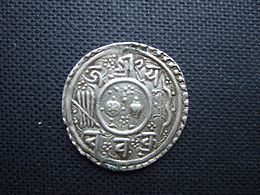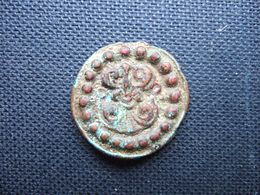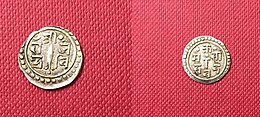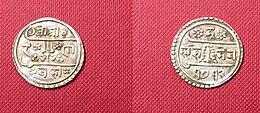Coinage of Nepal
| Part of a series on |
| Numismatics the study of currency |
|---|
 |
The earliest coin minted in todays territory of Nepal was in Shakya Mahajanapada which was along the India-Nepal border around 500 BCE . Shakya coins were an example of a coin invented in Indian subcontinent and continued to be used in Nepal along side India for over 1500 years.[1]
Coins from Indian Subcontinent
Post Maha Janapadas period (c.BCE 600-?)

Probably never Minted in Nepal but Maurya Empire. Punch marks were widely used in southern region of Nepal and also imported in hills and Kathmandu valley. Mauryan coins were punch marked with the royal standard to ascertain their authenticity.
Kushan Empire (c.CE 30–375 )

Another major coinage found in Nepal is of the Kushan Empire was a syncretic empire, formed by Yuezhi, in the Bactrian territories in the early 1st century CE. It spread to encompass much of Afghanistan[2] and the northern parts of the Indian subcontinent at least as far Nepal. These coins were widely used in Southern region of Nepal but was rarely used in Hills and Kathmandu valley region. These coins depicts the image of the Kushan kings and other Hindu and Buddhist Deity . Some scholars believed that Kushan King Kanishka's ascending of the throne in 78 CE,marked the beginning of the Saka calendar era which later was widely used up until 1600 in Nepal for dating coins. However, this date is not now regarded as the historical date of Kanishka's accession. Kanishka is estimated to have accessed to the throne in AD 127 by Falk (2001).[3]
Classical period of Nepal (c.CE 576-750)
Lichhavi Kingdom

The Licchavi Kingdom of Nepal established its root in the Kathmandu Valley from c.CE 576 to 750.It marks the beginning of Classical period of Nepal.Lichhavi Coins are the first coins widely used in Kathmandu Valley and its surrounding hills. Minted in copper these coins had legends in Gupta scripts, suggesting significant cultural influence of other major kingdoms of the Classical Period. These coins are religious in nature and few have Kings names depicted on it.[4]The known denominations of these coins are Pana(Tamrika), Purana, Pana-Purana, Matrika out of which some were struck in cast blank flans and some were stuck from cut piece. Some of the known coins are Mananka (c.CE 464-505 or 557), Amshuvermam (c.CE 557-605), Vaisravana (c.CE 621), Pashupati (c.CE 641-680), Gunanka (c.CE 625-641) and Jishnu Gupta (c.CE622-633) The only known conversion rate is 1 Karshapana = 16 Pana.[4]
The Medieval Period (c.CE 750-1540)
The coinage in Medieval Period of Nepal is known very little due to the lack of references and contemporary records about coinage of this period.Scholars believe that most probably due to Tirhut and muslim invaders from India the coinage system of Nepal failed and turned back to either using lumps of unstamped copper or gold dust and Islamic coins imported from India. Some inscription suggest that earlier Lichhavi coins namely Pana, Purana, Pana-Purana were continued until the introduction of new system by King Sivadeva/Simhadeva (c.CE1098-1126). The only known coins of this period struck by different minor rulers are Gold Sivaka, Silver Dam and later Nava-Dam-Sivaka and copper coin with legends Sri deva Yadasya.
Malla Dynasty (c.CE1540-1768)
After period death of coinage system a new coinage system developed in Nepal especially Kathmandu valley and Surrounding hills in the Malla (Nepal) of Nepal. These coins were struck by the sons of Yakshya Malla(- c.CE 1482) in separate kingdoms of Kathmandu, Bhadgaon, Patan and by Kings of Dolakha & Gorkha. The usual design on the coins, perhaps suggested by some of Akbar's and Jahangir's issues, consists of elaborate geometrically ornamented borders surrounding a central square or circle, with the legends in Nagari fitted into the spaces left in the design. On the obverse appear the king's name, titles and date, and on the reverse various symbols, accompanied sometimes by a further title or a religious formula.
Tankas Standard
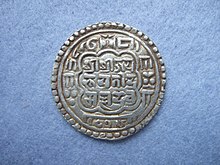
Tankas or Tanka were mostly debased silver coin struck in 10 g. weight with minor denominations of 1⁄4, 1⁄32, 1⁄123, 1⁄512 Tanka Dam. These coins were designed on the image of Muslim coins of Delhi Sultanate, Bengal and Mughal Empire which were widely circulated in Nepal by then. Initially Struck by King Indra Simha (-1545) of Dolakha followed by King Mahendra Simha (1560-74) of Kathmandu and finally by all three Kings.Most of these coins had no names and date except the one struck by King of Patan Siddhi Narasimha in NS 759 (CE. 1639).[5]
Mohar Standard
After a major reform in coinage New style of silver coins called Mohar(Initially called Mhendramalli)were struck in Nepal with reduced weight standard of 5.4 g. in silver. All three Kingdoms of the kathmandu valley along with Gorkha Kingdom struck these coins up until and with little modification after the unification of Nepal by King Prithvi Narayan Shah (1723–1775). These coins were struck in new artistic design of Hindu-Buddhist Yantra and were struck in the denominations of 1⁄4 Mohar called Mohar Suki(Generally in the name of the Queen) and 1⁄128 Mohar called Mohar Dam. They were struck with the date in Nepal Sambat and with a date in which the issuing king was coronated rather than the date of issue.[4]
Shah Dynasty(CE.1747-2008)
Prithvi Narayan Shah Before Conquest of the Valley
Before the Conquest of the Kathmandu Valley Prithvi Narayan Shah issued coins based on the existing Malla-Mohar system. First coin to be issued in his name was in CE. 1749, after which he issued few coins to mark special occasion and in need of the Unification of Nepal. One of the few innovative difference between Shah's coin and Malla coins are that the coins are struck with date of issue rather than year of coronation and change in the dating system from Newari Samwat to Saka era. Along with the coins issued as a king of Gorkha few coins from Patan were also issued in Prithivi Narayan Shah and his wife Queen Narendra Rajya Laxmi Devi's name after he was unanimously selected as a King of Patan.[5]
After the Conquest of the Valley
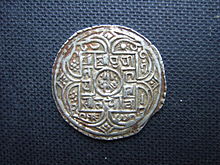
After the conquest of Kathmandu valley King Prithivi Narayan Shah withdrew all the old Malla currency and in order to stop there circulation ,devalued there exchange rate. Apart form regular issue of Mohar, Suka, dam coins were struck in queen Narendra Lakshmi's name and a new coin double in value and weight of Mohar were struck equivalent to Indian Rupee. Some gold coins were also struck in his reign but as Nisars for use in special ceremonies. Prithivi Narayan Shah's Successor continued with his modifications in Malla currency and dating system and continued issuing similar silver and Nisar gold coins in their and their queens names. In 1789 (Sak.1711) King Rana Bahadur Shah reduced the diameter of Mohar and increased the production of smaller denomination and gold coin.
Regent Queen
Several Suki coins were issued by the Regent Queens of Shah dynasty due to power shift in the court .In Sak.1722 Queen Raj Rajeshwari Devi senior wife of Rana Bahadur Shah issued her own suki currency as a regent of infant King Girvan Yuddha Bikram Shah followed by her successor regent Suwarna Prabha Devi (Sak.1723). Followed by Raja Rajeshwari Devi again in Sak.1724 and Probably with different names (Amar Rajeshwari and Mahamaheshwari).[5] Rajendra Rajya Laxmi Devi
Copper coinage in Valley
In CE. 1865 First copper coins were issued for the Kathmandu Valley in the denomination of Copper Paisa, Double Paisa and Dam with inscription in Devanagari script.[4]
System
Tanka Standard
- 1 Tanka
- 1⁄4 Tanka
- 1⁄32 Tanka = 4 Dam
- 1 Dam = 4 Jawa
Silver Mohar System(After 1640)
- Double Rupee = 4 Mohar
- 1 Rupee /Double Mohar = 2 Mohar
- 1 Mohar = 4 Suka
- 1 Suka = 2 Ani
- 1 Ani = 2 Adha-ani
- 1 Adha-ani = 2 paisa
- 1 Paisa Mohar = 4 Dams
- 1 Dam = 4 Jawa
Copper Standard
- 1 Ganda or Ani/Aana = 2 Dyak or 2 Double Paisa
- 1 Dyak or 1 Double Paisa = 2 Dhebua or 2 Paisa
- 1 Dhebua/Paisa = 4 Dam(Copper)
Gold coin System
- Duitole Asarfi = 4 Mohar = 2 Tolas = 360 troy grain
- Bakla Asarfi = 2 Mohar = 1 Tola = 180 Troy grain
- Patla/Majhawala Asarfi = 1 Mohar = 1⁄2 Tola = 90 troy grains
- Suka Asarfi = 1⁄2 Mohar= 1⁄4 Tola = 45 Troy Grain
- Suki = 1⁄8 Mohar= 1⁄16 Tola = 22.5 Troy Grains
- Ani = 1⁄16 Mohar = 1⁄32 Tola = 2.93 Troy Grains
- Adha-Ani = 1⁄32 Mohar = 1⁄64 Tola = 5.87 Troy Grains
- Pal = 1⁄64 Mohar = 1⁄128 Tola = 2.93 Troy Grains
- Dam = 1⁄154 Mohar = 1⁄317 Tola = 0.71 Troy grains[6]
Gallery
-
Nepalese silver mohar in the name of king Chakravartendra Malla of Kathmandu, dated Nepal Sambat 789 = AD 1669, obverse
-
Nepalese silver mohar in the name of king Chakravartendra Malla of Kathmandu, dated Nepal Sambat 789 = AD 1669, reverse
-
Copper coin of Jishnu Gupta (c. 622-633) of the Nepalese Licchhavi Dynasty. Reverse
-
Gunanka.
-
Half Mohar Rajendra Vikrama
-
Suka Mohar Rajendra Vikrama in the name of Queen Samrajya lakshmi.
-
1-8 Mohar Rajendra Vikrama
-
Half Mohar Rana Bahadur Shah
-
Uni-face Silver Dam Girvana Yuddha.
-
Rana Bahadur 1 paisa.
-
Rana Bahadur Half paisa.
Rana Bahadur Half paisa
See also
External links
"Notes and Coins of Nepal" (PDF). Nepal Rastra Bank. Retrieved 24 November 2016.
References
- ^ "The COININDIA Coin Galleries: Shakya Janapada". Coinindia.com. Retrieved 2012-05-22.
- ^ http://www.kushan.org/general/other/part1.htm and Si-Yu-Ki, Buddhist Records of the Western World, (Tr. Samuel Beal: Travels of Fa-Hian, The Mission of Sung-Yun and Hwei-S?ng, Books 1–5), Kegan Paul, Trench, Trubner & Co. Ltd. London. 1906 and Hill (2009), pp. 29, 318–350
- ^ Falk (2001), pp. 121–136. Falk (2004), pp. 167–176.
- ^ a b c d Nicholas G. Rhodes; Karl Gabrisch; Carlo Valdettaro Pontecorvo della Rocchetta (1989). The coinage of Nepal from the earliest times until 1911. Royal Numismatic Society. ISBN 978-0-901405-27-2.
- ^ a b c Joshi, Satya Mohan (1961). Nepali Rashtriya Mudra (National Coinage of Nepal). Archived from the original on 2016-11-30. Retrieved 2016-11-30.
{{cite book}}: Unknown parameter|deadurl=ignored (|url-status=suggested) (help) - ^ American Journal of Numismatics. [American Numismatic Society[. 1917. pp. 231–.
{{cite book}}: CS1 maint: extra punctuation (link)

